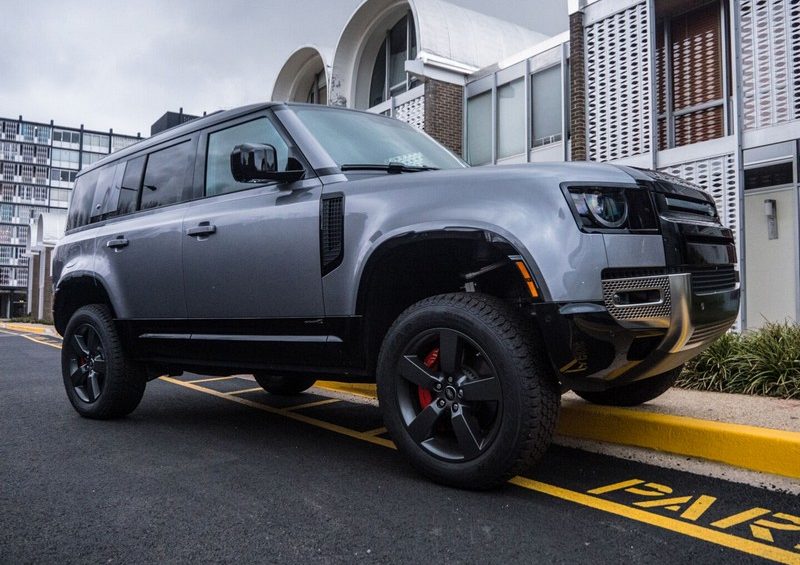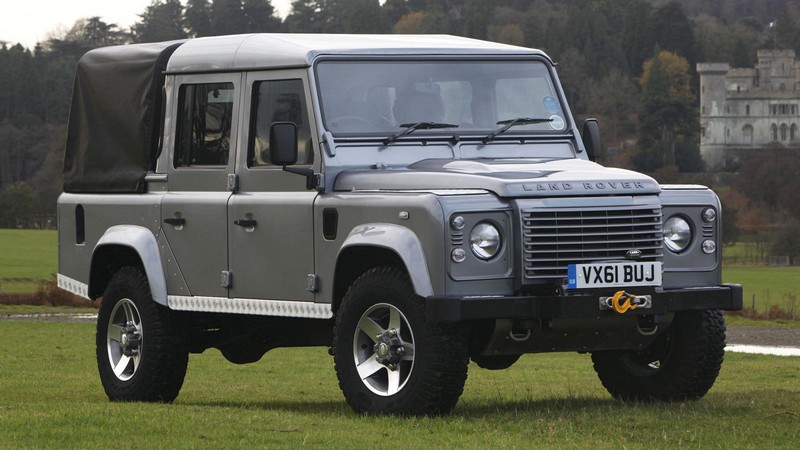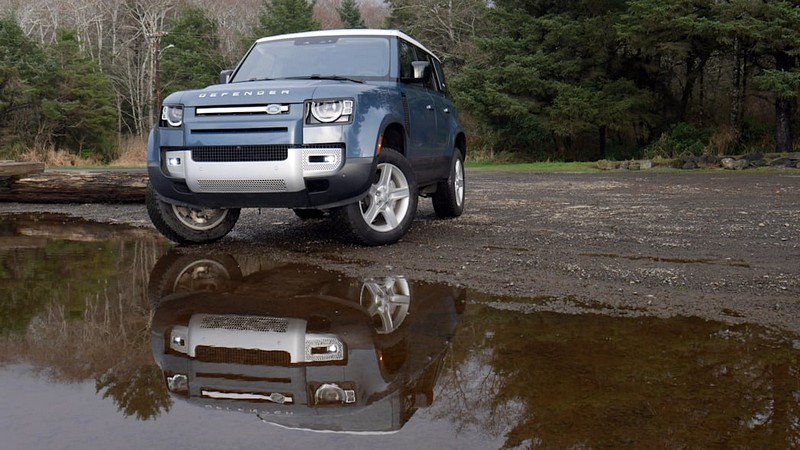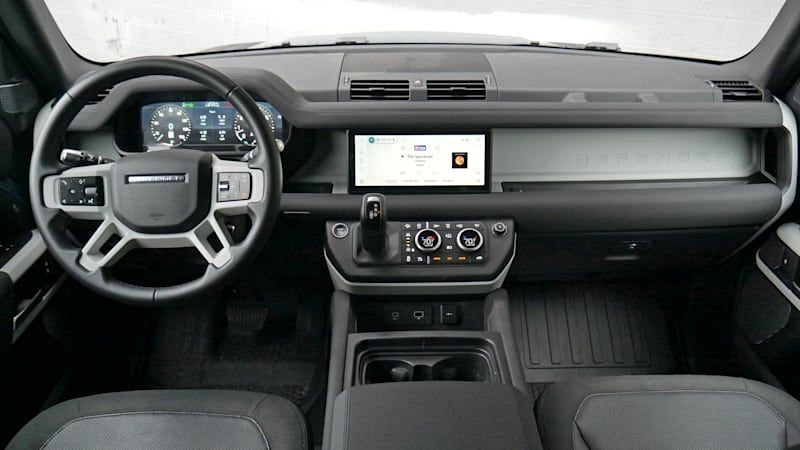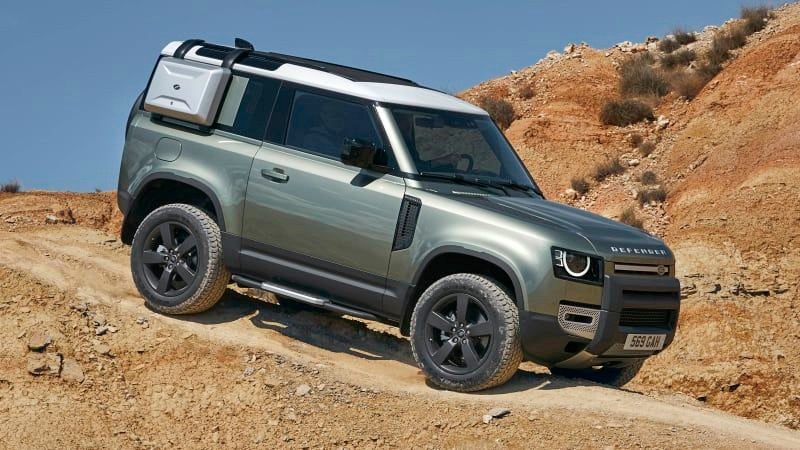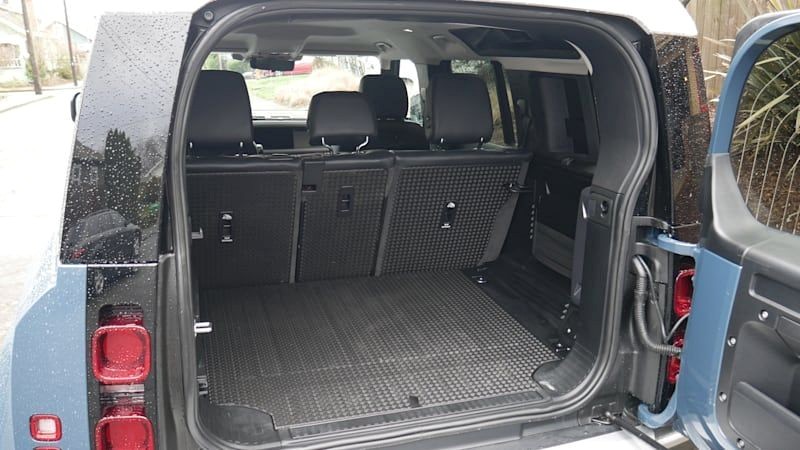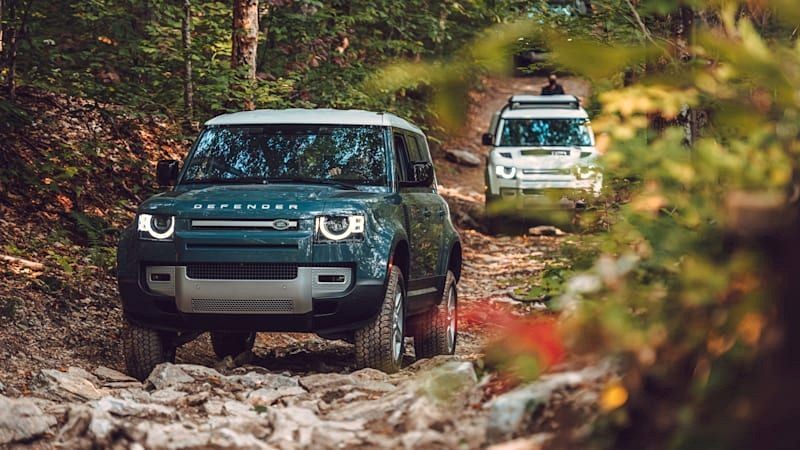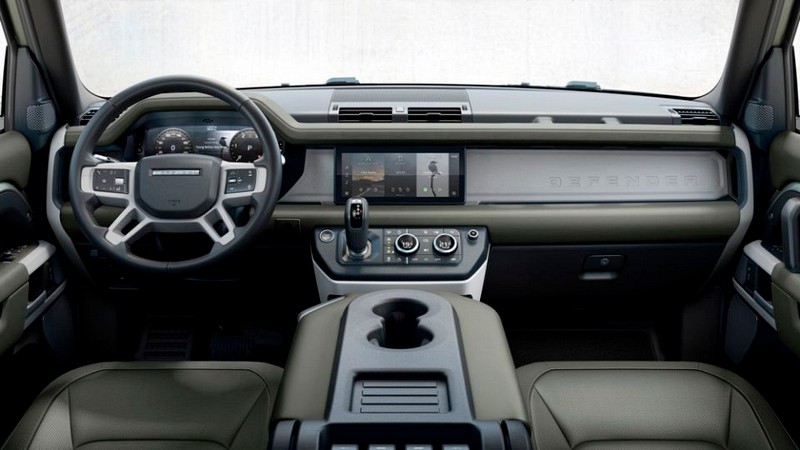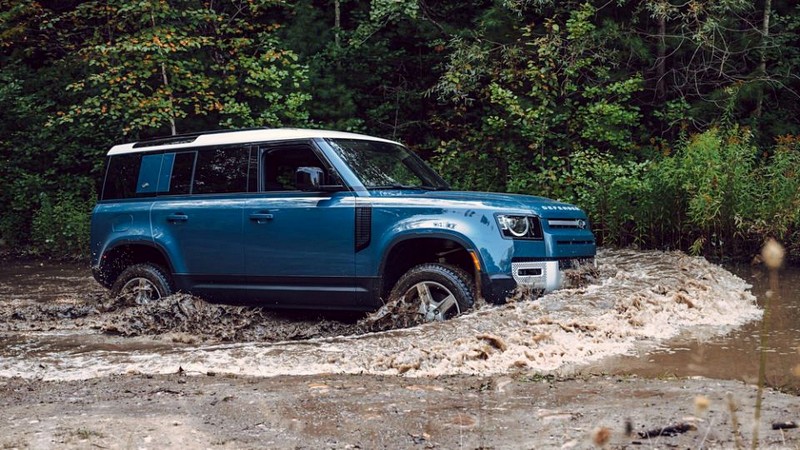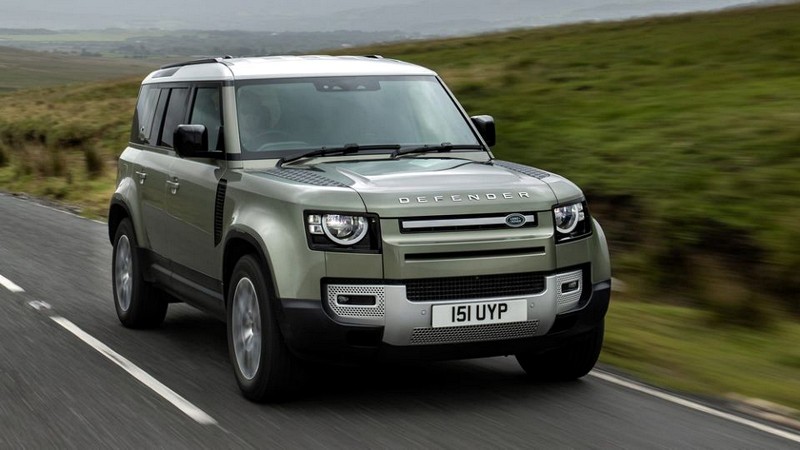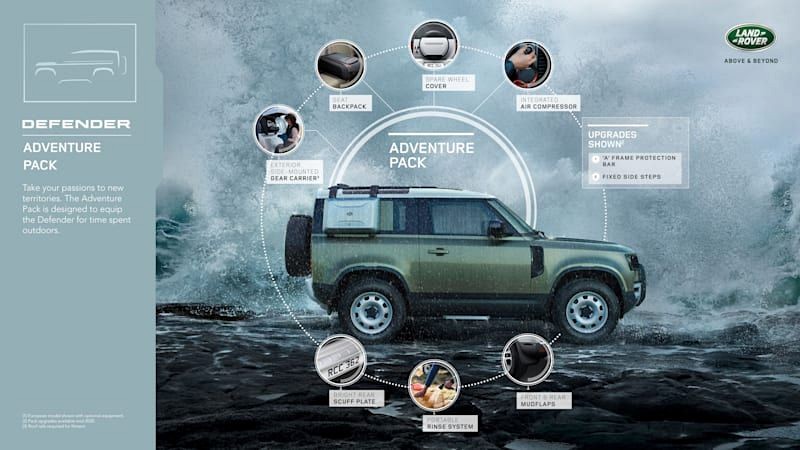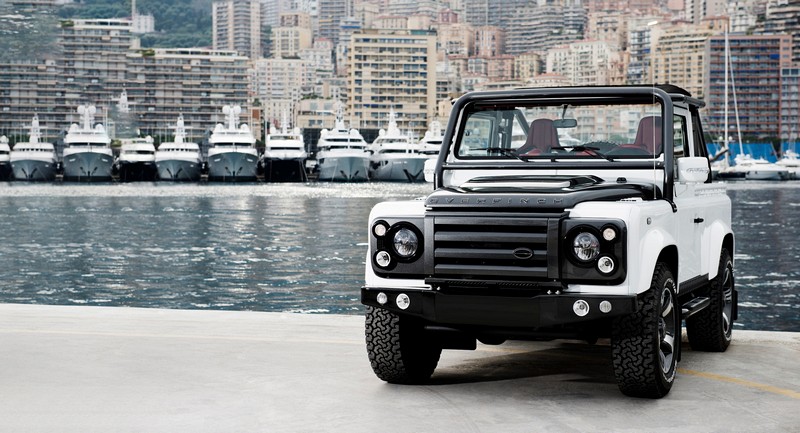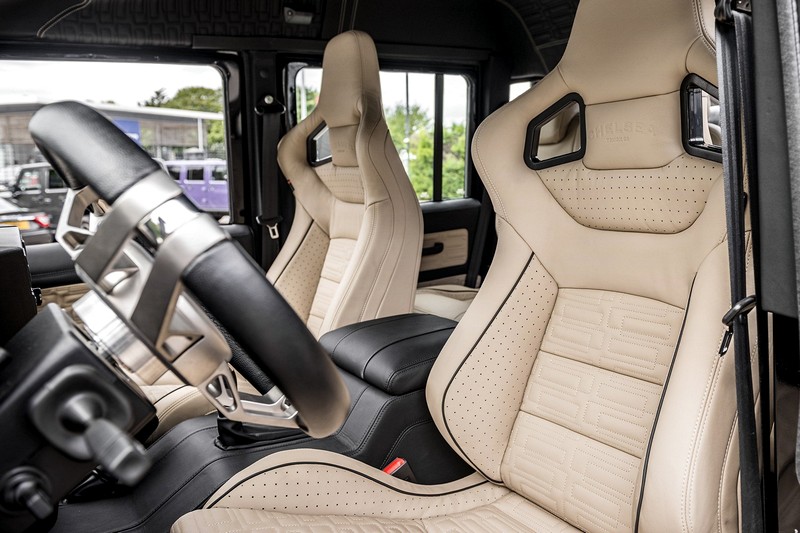For many in the United States, the name Land Rover Defender will be a new one. Oh sure, the illustrious original was sold for a few years in the 1990s and you’ll see them here or there as imported classics, but the weight of history just isn’t anchored to the name Defender here. They were never mainstays on farms or military bases, nor were they ever the off-roader of choice for serious off-roaders. We didn’t take them on safari and we definitely don’t have a queen who owns and drove several. And so, without historical preconceptions, we are free to accept the 2021 Land Rover Defender exactly as it is: an exceptionally versatile and well-rounded SUV.
It is equal parts stylish and functional; capable and comfortable; luxurious and rugged. Available in the four-door 110 model and, for 2021, the two-door Defender 90 model, it’s most obviously reminiscent of America’s own quintessential off-roading SUV, the Jeep Wrangler. However, as it’s a modern Land Rover (and pricier), its engineering is more sophisticated, most notably its all-independent air suspension that can raise it high to clear obstacles while also delivering a truly excellent ride, especially for an off-roader. Its steering and on-road handling in general are also far superior to the Wranglers and Toyota 4Runners of this world, while its choice of turbocharged inline-four and mild-hybrid inline-six provide stout power and contribute to a robust 8,200-pound towing capacity.
Inside, the 110’s cabin is genuinely family friendly with a large back seat and abundant cargo space. You can even get a three-person front seat in both models (oddly appealing) and an optional third-row seat in the 110 (pretty much useless). The Defender also has a more rugged design than other Land Rovers along with easily cleaned rubber flooring throughout, yet still boasts materials quality appropriate for a vehicle carrying a luxury price tag. But here comes the downside. The Defender is quite expensive, starting at more than $50,000 for the 110 and running into the mid-$80,000 range – it’s still a midsize SUV from a luxury carmaker and it’s priced as such. We think it’s ultimately more appealing on its lower end. It’s always well-equipped, and the higher you go, the harder it gets to justify when compared to range-topping Wranglers and 4Runners, or more luxurious midsize SUVs with similar prices.
What’s new for 2021?
Though it was introduced to the world at the same time as the 110, the Defender 90 actually goes on sale for 2021 (though it will be delayed). It slices off a considerable amount of wheelbase, overall length and cargo space from the Defender 110 in order to achieve greater maneuverability. It’s also cheaper. A new Defender X-Dynamic trim level also debuts with a tougher exterior design and different interior trappings.
What’s the Defender’s interior and in-car technology like?
With its bold horizontal lines, metal trim, rubber flooring, numerous grab handles and bins galore, the Defender’s cabin has an undeniably rugged and functional vibe. Certainly more so than any other Land Rover. However, it may be rugged in appearance, but the materials used are generally top-notch stuff worthy of commanding its top-notch price tag. Top trim levels can also be spiffed up with open-pore wood trim and fancy two-tone leather choices.
Standard on every Defender is Land Rover’s Pivi Pro wide touchscreen interface. Handsomely sandwiched in between the dash’s prominent horizontal cross-members, it almost appears to be a cool retroactive modification. Its graphics and overall aesthetic make strong initial impressions. However, it can be slow to respond, we’ve found it to be buggy at times and the layout for certain functions such as the audio system is unusual (song info and radio presets are annoyingly always on separate pages). It also doesn’t take advantage of its widescreen layout with a split screen option. The optional all-digital instruments make a stronger impression, as they offer different design choices that’ll provide as much or as little info as you’d like. That said, we’d also be just fine with the standard analog gauge cluster and smaller central screen.
How big is the Defender?
The answer very much depends on the Defender model. The 90’s wheelbase is 10 inches shorter and its overall length is 17 inches shorter than the 110’s – that’s significant. The result is a considerably more maneuverable vehicle off-road and a considerably smaller cabin (you see the differences between the two in the photo gallery below). Backseat legroom is actually fine, as its 36.6 inches is only 1.8 less than the notably spacious 110. Cargo space is an entirely different matter. The 90’s tiny 15.6 cubic feet is less than what you get behind the third rows of many midsize SUVs. In the Defender 90, you’ll definitely need a cargo carrier or will have to leave your friends behind.
That probably won’t be necessary in the Defender 110, which has a big, boxy cargo area that we found swallows even more than its 35.4 cubic feet would indicate. There’s also plenty of thoughtful storage solutions throughout, plus highly configurable roof rails. Maximum capacity stands at 70.4 cubic feet, and the Defender has a fold-flat load floor.
Now, the Defender 110 offers a third-row seat, but it’s so tiny and leaves even less cargo capacity behind it that it’s just not worth considering. If you need three rows, get a Land Rover Discovery and just lament the fact that it’s not cool and boxy like the Defender or the old LR4.
What are the performance and fuel economy?
The standard Defender engine is a 2.0-liter turbocharged inline-four that produces 296 horsepower and 295 pound-feet of torque. An eight-speed automatic is on board along with a permanent four-wheel-drive system. Fuel economy is 17 mpg city, 20 mpg highway and 18 mpg combined in the 110 (the 90 is 18/21/19), and Land Rover says the 110 will go from 0 to 60 mph in 7.7 seconds. Both of these are unimpressive for a luxury SUV of its size (think a BMW X5), but also not bad for a heavy off-roading SUV.
The optional 3.0-liter inline-six features a smorgasbord of power-enhancing elements: a turbocharger, an electric supercharger and a mild-hybrid system. Output is a significant step up at 395 horsepower and 406 pound-feet. The 0-60 time falls to 5.8 seconds in the 110 and 5.7 for the 90 (despite the dimensional differences, the smaller version only weighs 200 pounds less). Fuel economy increases slightly to 17 mpg city, 22 mpg highway and 19 mpg combined and is the same for both body styles.
What’s the Defender like to drive?
Like other Land Rovers, the Defender’s air suspension results in a controlled, buttery smooth ride that’s better than the vast majority of other SUVs, let alone rugged off-roaders like the Wrangler and 4Runner. Its steering is slow and requires plenty of turning per the off-roading norm, but it’s also incredibly precise and provides impressive feedback for something so capable of climbing rocks. The long-travel brake pedal will definitely take some getting used to if you’re coming from a crossover or car, but the brakes are easily modulated and you get used to them. In total, there’s really no contest when it comes to on-road drivability between the Defender and those other off-roading competitors. Of course, the Land Rover is also a lot more expensive.
Off-road, we found it to be just as impressive thanks to its stiff “D7x” all-aluminum monocoque, class-topping approach and departure angles, optional adjustable air suspension, new screen-based Terrain Response system, two-speed transfer case, and with the 3.0-liter engine option, a standard locking center differential and optional active rear-locking diff. Those are joined to systems that — should you choose — take all the guesswork out of four-wheeling, including a water-depth wading sensor and a camera view that essentially makes the hood disappear. This is an invaluable feature when negotiating rocks or cresting a hill without a spotter – is that an equal slope on the other side or a precipice?
As for the engines, the base inline-four’s 0-60 time won’t wow, but its abundant torque and smart ZF automatic transmission should make it feel quick enough. Perhaps more to the point, the turbocharged, supercharged and mild-hybrid 395-hp inline-six very much seems like overkill. In our 200-plus miles behind the wheel on a trip up and over Oregon’s coastal mountains, we never came close to needing its full potential despite climbing steep grades and passing slower vehicles. It also adds even more complexity to an already complex vehicle from a brand with decades of questionable reliability.
What more can I read about the Land Rover Defender?
Land Rover Defender 110 Luggage Test | Boxy is better
Taking a close look at all the Defender’s many cargo-related features and design elements, plus how much it can bit behind its back seat (the picture below is a hint).
2020 Land Rover Defender Interior Tour
A closer look at the interiors of both the Defender 110 and Defender 90.
2020 Land Rover Defender 110 First Drive | As good as you hoped
Our first drive on American soil of the Defender 110, including off-roading driving impressions.
2020 Land Rover Defender British First Drive
British correspondent Andrew English drives the Defender on its home turf.
What can I watch about the Defender?
2021 Land Rover Defender 110 in Colorado
We make the Defender look pretty in this exclusive video of the Defender in beautiful Colorado.
What features are available and what’s the price?
Pricing starts at $47,450, including the $1,350 destination charge, for the 2021 Defender 90. The Defender 110 starts at $51,850. Each is available with different trim levels, but the 110 has more.
We didn’t have a full breakdown of 90 equipment at the time of this writing, but apart from a standard steel suspension instead of the 110’s standard adaptive air suspension, the two should be similar.
To that point, despite being expensive, the Defender 110 is at least well-equipped. Besides the air suspension, it comes with Land Rover’s Terrain Response system, automatic-leveling LED headlights, heated power-folding mirrors, “Alpine Lights” (those little skylights in the roof), 18-inch gloss white steel wheels, proximity entry and push-button start, rubber flooring, leather-wrapped steering wheel and shifter, fabric upholstery, eight-way power front seats, 40/20/40-split rear seats, dual-zone climate control, numerous driver assist systems (see Safety section below), a 10-inch touchscreen, integrated navigation, in-car Wi-Fi, Apple CarPlay, Android Auto, a six-speaker sound system and HD radio.
That’s a lot of stuff, and apart from maybe upgrading the wheels to alloy (the steelies look cool, but come on) and the upholstery to leather, we don’t think the SE trim and/or adding many options is that necessary. The fancy-pants upper trim levels really aren’t, and seem a bit anathema to the Defender’s rugged character.
Still, you can find a full breakdown of their features, specs and local pricing here on Autoblog. Note the X-Dynamic trim levels largely signify appearance packages.
Defender 90: $47,450
Defender 90 S: $50,750
Defender 90 X-Dynamic S: $59,150
Defender 90 X: $81,850
Defender 110: $51,850
Defender 110 S: $55,150
Defender 110 SE: $64,050
Defender 110 X-Dynamic SE: $66,050
Defender 110 X-Dynamic HSE: $72,950
Defender 110 X: $84,350
Finally, Land Rover offers a wealth of special accessories for the Defender, both as separate pieces and within packages. You can see some of these in the photo gallery below.
What are its safety equipment and crash ratings?
Standard on every Defender is forward collision warning, automatic emergency braking, lane-keeping assist, blind-spot warning, a driver inattention warning system, a 360-degree parking camera and wade sensing (basically a sonar system that can tell you how deep water is). Adaptive cruise control is a stand-alone option.
The Defender had not been crash tested by a third party at the time of this writing.
PHOTO GALLERY
[ngg src=”galleries” ids=”7″ display=”basic_thumbnail” thumbnail_crop=”0″]
Article Credit: James Riswick
Full Article: https://ph.news.yahoo.com/2021-land-rover-defender-review-141500188.html

